The City of Portland has enhanced the bikeway on SW 13th at SW Clay Street. The existing bicycle only lane which runs on the right of the one-way street, has been beefed up as it approaches the intersection. Now instead of just one stripe of paint to separate bicycle and motor vehicle operators, PBOT has added a buffer zone and five flexible plastic “candlestick” wands (also called delineators).
“There was some conflict happening there. And we think we can make a big difference with a small amount of money.”
— Dylan Rivera, PBOT
City spokesman Dylan Rivera says this small project cost just $2,000 and it came out of the bureau of transportation’s “missing links” budget. That small pot of funds (about $50-100,000 annually) is set aside for fixes to bike network gaps.
SW 13th in this location has four lanes: one auto parking lane, two standard lanes, and a bike-only lane. Because SW Clay is an on-ramp to Highway 26 (westbound), many people who come onto 13th were using the bike lane as a right turn lane. Either that, or people in cars would encroach into the bike lane prior to Clay in anticipation of getting on the highway.
Below is a Google streetview image from July 2015 that shows this encroachment…
Rivera said the problem was flagged by a member of PBOT’s Traffic Safety Coordination Council, a group made up of advocates, volunteers, and city and other regional agency staff that meets each quarter in City Hall.
After hearing the suggestion, PBOT agreed something needed to be done. “There was some conflict happening there,” Rivera said via a phone interview last week. “And we think we can make a big difference with a small amount of money.”
Rivera added that the plastic delineators (which stand four feet high) and painted hash marks are spaced more closely together as you approach Clay. “What that does is give the motorist the perception that they’re going faster and that they need to slow down.”
@PBOTinfo pioneers better protection near Jefferson & 14th. Safety doesnt have to have a presidential price tag. pic.twitter.com/5fQvKXStUW
— Timur Ender (@timurender1) December 28, 2015
After seeing this first posted by Commissioner Steve Novick’s transportation policy advisor Timur Ender on twitter on December 28th, I went out to see it for myself.
Advertisement
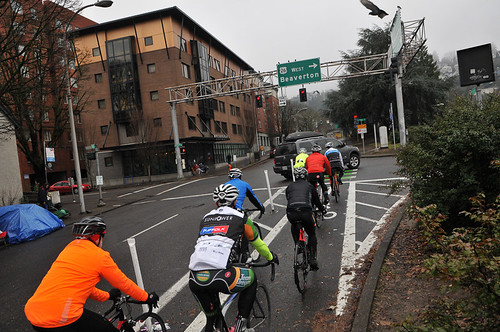
I’m a fan of using these plastic delineators, but PBOT seems to have still not learned how to keep them in the ground. Remember the debacle when these where installed on the NW Lovejoy ramp off the Braodway Bridge east of 9th? They were supposed to help separate bicycle and auto traffic, but they were repeatedly ripped out by people who hit them with their cars and PBOT eventually gave up on them.
One of the new delineators installed on Clay met the same fate less than 24 hours after it was installed. (I was out there last week so I’m not sure how many still remain standing). If the posts stay in place, this project should be a great improvement. While I was there, people seemed to slow way down before turning, and no one entered the bike lane prior to the intersection.
In addition to the striping and delineators, PBOT has added some green caution color to the bike lane in the intersection and a sign that warns people who are turning to yield to people on bikes. Below is PBOT’s plan drawings of the intersection…
Rivera and Ender are right: these little projects have tiny price tags but yield big benefits for our network. We need to do a lot more of them. In fact, Ender told us he’d be happy to see a list of other intersections where this type of fix is needed. Let’s hear your ideas. I’ll forward to the list to Ender and hopefully we can fix more intersections soon.
— Jonathan Maus, (503) 706-8804 – jonathan@bikeportland.org



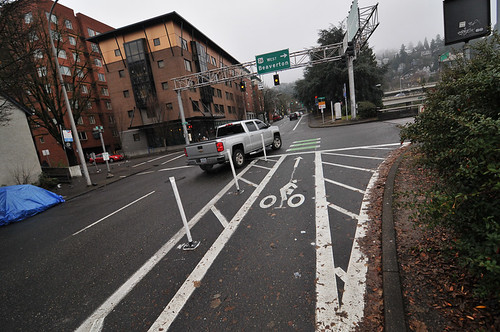
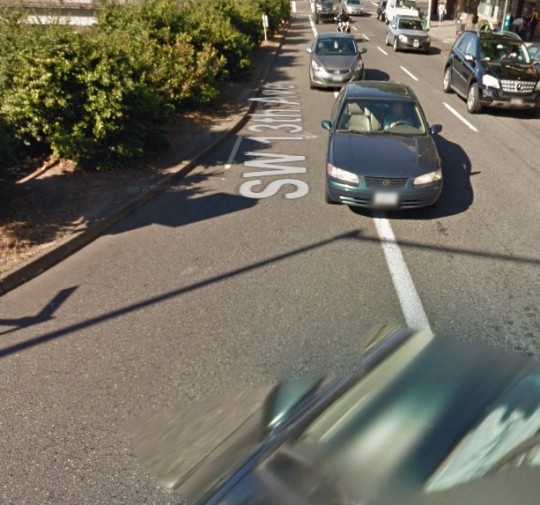


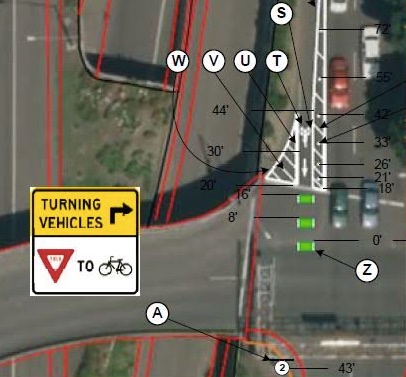
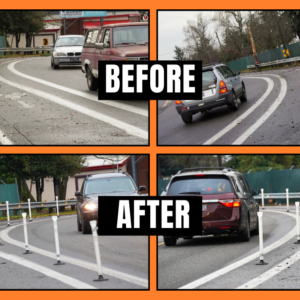

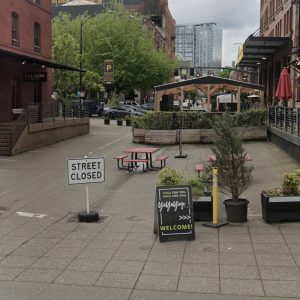

Thanks for reading.
BikePortland has served this community with independent community journalism since 2005. We rely on subscriptions from readers like you to survive. Your financial support is vital in keeping this valuable resource alive and well.
Please subscribe today to strengthen and expand our work.
Thanks, PBOT, this is a great improvement! Let’s add these flexible bollards to all of our bike lanes! 😉
I’m not sure how I feel. I reckon this is probably good, but at the same time I’m curious if the extra buffer at the end would put someone on a bike in a driver’s blind spot, and end up with the driver suddenly swerving in front of the bike lane and causing a collision, especially with how antsy people get around this area during rush hour. Maybe a bit of a situation like NW Everett/16th had.
While it would be way more than $2000, what I’d really love to see here longer term is a left hand bike lane. I’d imagine this street is one of the most ideal in Portland for it. Virtually no one on 13th is turning left (based on my experience, I don’t have data to back that up), and as of now if you approach 13th from most streets, you get a stop sign and have to sprint across two lanes of traffic to get into the bike lane in the first place, which I can also say is terrible during rush hour. So moving the bike lane to the left would eliminate the on-ramp tension altogether. Use the parking spots as a buffer, add some hook turn boxes for Jefferson (and others), good to go.
Still, I really do hope this improves the situation. Thanks PBOT!
A left hand bike lane could be good here, as long it is on the left side for the entire length of the street. It would be really undesirable to replicate the recently created situation at 14th & Taylor (https://goo.gl/maps/XGoo93oRc932), where bike riders are suddenly expected to merge across two lanes of fast moving traffic as the bike lane transitions from the left to the right.
–What he said! SW 14TH / Taylor gets my vote for Most Implausible Mess Passing As Bike Infrastructure, 2015. Who would actually ride that line?
Left-hand bike lanes are fairly contentious. When I first moved to Santa Clara they were exploring options on a low-speed street not unlike a Portland Neighborhood Greenway. After many public outreaches and hearings and requesting public input on three proposals, a left-hand bike lane was chosen. After it was built there was a fair amount of ridicule from the public – especially cyclists. I myself find it strange to ride in, mainly because I’m so used to having a feel for car traffic to my left, and also because that’s where my mirror is (and taillights are aimed).
I hope someone gives me some warning about future left-side bike lanes so I can add a right side handlebar mirror. N Williams works well for me in theory, but I’m not used to having to turn around to see vehicles (including bikes) coming up behind me. Probably should get one anyway if only to see (insert derogatory word here) cyclists passing me on the right in a bike lane.
drivers likely didn’t know that it was a bike lane before… there wasn’t a bike symbol in it, only a diamond… a diamond in Portland can mean either bike lane, carpool lane, or train lane… we’re left to guess which it is…
my gf just took the Oregon driver’s test and there were no bicycle-related questions… so it’s tough to fault a driver for this one…
there should be bike symbols in all bike lanes every now and then (100 feet?) plus one at the beginning and end of each block or anywhere there’s a break in the bike lane…
The driver’s test is full of arcane multiple-choice nonsense in place of stuff that could help vulnerable users. Look at this question from one of the practice tests:
You are driving at night and a car is coming toward you. To help avoid blinding the other driver with your headlights, you must dim your lights when the other car is within:
500 feet
450 feet
400 feet
350 feet
Seriously? Drivers are calculating the difference of 50 feet when determining when to dim their lights?
To avoid trouble, I usually leave my lights off when I drive. I hate to risk blinding anyone.
You’re being snarky, but I’m guessing roughly 5% of drivers in outer SE don’t know that their brand-new SUV has headlights.
I had to take the driver’s test about 4yrs ago to get my OR license after moving back from PA. Was appalled that there were 0 questions about bicycles. There were several about administrative details that don’t apply to most people more than once on a blue moon. If I’m selling a car I’m going to go look up the rules on reporting it because it’s probly changed. It’s also something that’s only going to apply to me maybe once every 10-15yrs.
Not too useful as a test question. Cyclists on the other hand I encounter every single time I drive or ride. Seems pretty clear to me which is more important to make sure people know about.
“my gf just took the Oregon driver’s test and there were no bicycle-related questions… so it’s tough to fault a driver for this one…”
I think you’ve just made a very -perhaps the most- salient point of the day… or year. Road culture revolves around cars. Heck, even your state issued ID is an operator’s license for a motor vehicle!! As long as the DOT views bicycles as something that children play with in the park, the deep seated road culture will continue with imbalance.
to my eye, this appears to force motorvehicles to turn across the bike lane at an angle which would minimize the blind spot (assuming they are paying attention).
curb-style delineators that are physically attached to pavement would help make this a more permanent facility.
“We’ve replaced these plastic wands with plastique wands. Let’s see if drivers notice the difference…”
Or make the end closest to the intersection out of steel pipe filled with concrete, and as the plastic bollards are knocked down and replaced the one next to the end is replaced with steel, then the next and the next after that until the entire lane is protected by immovable steel bollards.
It is for this reason why curbs are better for protection.
Replace the last matchstick with a nice heavy concrete planter, just to be extra sure 🙂
I drove through here on late Thursday afternoon. I knew I needed one of these upcoming right turns, and as soon as I saw the sign I put on my blinker and checked my mirrors to start turning to the right. It was then that I noticed the reflective bollards, and they showed up pretty well in my headlights. It definitely sends a clear signal to the driver (especially Californians*) not to cut far right, and to yield to cyclists there. I also think as a driver you may have a better chance of seeing a cyclist with that sweeping arc across their trajectory (actually something I’d love to see studied).
*I say “especially Californians” as their laws would have them take that right turn by moving as close as practicable to the right curb 100′ in advance – the bollards would catch anyone used to that off guard (moreso than the green paint).
This is an example of what I call “the language of infrastructure” – tells people fairly clearly what to do and what not to.
And oh yeah, I certainly didn’t notice that sign to “yield to bicyclists”… probably because I was looking in the other direction to ensure not cutting off oncoming bicyclists.
Maybe they should put the sign behind you, so you’ll see it?
http://bikeportland.org/2016/01/04/city-adds-plastic-protection-to-bike-lane-on-sw-13th-at-clay-171393#comment-6609711
As other people have mentioned, this is a problem intersection because of it serving as an access to Hwy 26th. I’m looking at the pics and diagrams to understand why a main lane right turn only lane wasn’t located to the far right side (with the bike lane to its left.) of the road. I suppose that would mean reducing two of the main lanes to just one on this block.
I have to wonder also, what type rider this bike lane configuration is hoped to serve best. Certainly not the road riders shown in the one picture…with little problem, they could ride the gentle uphill in the main lane, holding their own with traffic. Who it may serve best, comes next to the slower paced riders discussed in today’s Roundup. Will this help the 8mph average speed crowd?
Personally, while I realize the city’s intentions towards all road users, but particularly people that ride, must be good with respect to this design…I tend to think the design in actual use may turn out to be not so good for safe and smooth traffic flow.
People driving and wanting to turn onto the freeway, may hang up at the intersection, trying to spot people on bikes passing through on the bike lane. I think the paint and the bollards may delude some people biking in this bike lane, into feeling they need not watch their position relative to motor vehicles in the main lane next to them…to avoid right hooks.
Nice effort though…let’s watch and see how it works out.
“People driving and wanting to turn onto the freeway, may hang up at the intersection, trying to spot people on bikes passing through on the bike lane.”
Agreed, though it’s actually something I like about this. If you get any volume of cyclists coming through here at peak traffic times, I’m betting car traffic will indeed back up in the first lane. The bollards will cause that to happen, not the bicyclists, and not really the green paint either.
I don’t think it takes much time to spot-check the bike lane for occupants in general practice, as an observant driver would notice them while on approach to the turn. I had two other cars in front of me, with the first going straight and then the car in front of me turning right as well. It was already getting dark but still pretty clear sight lines so I would have easily seen someone approaching. I think one of the factors that attributes to the stats that Soren quoted below is when infrastructure doesn’t force that pause or hang-up, so instead it gets really easy for drivers to tailgate each other around the corner with only a slight turn of the steering wheel.
Also agree with your last statement – I wonder if there was a track record of (reported) problems here before, to compare to?
Yeah, Californian and the people from the forty-seven other states that consider bike lanes to be part of the roadway and thus mandate that all vehicles making right turns make them from the lane nearest the edge of the roadway, which is the bike lane.
We’re the odd state out here. It seems lame to not be able to get widespread standardization on such a simple and common traffic movement.
Well, to be fair, there does seem to be widespread standardization.
We’re definitely on the same page there, as I’ve said before on here that I’d love to see road rules and driving administrations move under a federal governance rather than state-to-state. I think it would save taxpayers a chunk of money, as well as be able to effectively improve nationwide driver education (for example, say Oregon comes out with better education about bike and ped rules and starts to incorporate it into testing – in theory only Oregonian drivers would benefit from that improvement… I know, it’s a stretch).
Another thing I thought of is that in California it would be highly unlikely to get a treatment like this. You could get the buffer and the green paint, but the bollards would actually prevent drivers from complying with the law. There is one road I ride a lot (E Fremont in Sunnyvale) where 1′ paint buffers were added, which caused the outside line to stay solid while the inside line remained dashed (CA dashes the merge zones). After this, I definitely noticed that most drivers were staying to the left of the solid line and cutting across, rather than actually merging (as the law requires). I mentioned this when attending Sunnyvale’s BPAC meeting, and one cyclist said he’d written to the city complaining that this was a more dangerous behavior! Just the paint alone made this noticeable difference.
Anyway, my point is that the “merge vs cut” debate has occurred many times here on BP in the past and will always rear its ugly head in cycling discussions, but regardless, I’m convinced that treatments like this definitely change road user behavior, if nothing more than the change itself causes regular drivers to take notice.
Jonathan, you say you like these bollards, but that PBOT has trouble keeping them in the ground.
Do you think it is something unique to PBOT or unique to the bollards? I think the latter, and while this might be a lightweight (literally) and temporary measure to “try it out”, to REALLY separate bikes and cars, a more permanent and sturdy solution would help. For that I think at least a curb, or some concrete barriers.
Both. Not all of these plastic bollards are built the same. The ones the County uses on the Hawthorne viaduct approaching SE Grand have a much more solid base that seems a lot tougher.
I don’t think PBOT is doing this is a temporary fix. I’m not sure exactly why they don’t build a more secure and solid installation. Seems pretty simple to me, but then again I’m not an engineer.
Almost certainly due to lack of funding, which in turn is caused by a lack of political will. Now that the holidays are over, I’m looking forward to City Council campaigning for the proposed ten cent gas tax.
They are designed to break off/fold up for emergency vehicles or accidents. The one that took its base with it was not installed properly.
There are two types, the collapsible kind that just fall over or the kind with a defined break point at the base. If you have a bollard that is too secure and vehicles hit it, you end up with safety concerns. Some vehicles have enough weight (and energy at at speed) to bend the bollard and launch said vehicle airborne. Airborne vehicles are not safe. So the design is made to collapse or break off if hit hard enough.
These permanently attached delineators are installed elsewhere in PDX and would be a better solution here:
http://farm8.staticflickr.com/7370/10215582363_4e264c8faf.jpg
I don’t believe airborne vehicles should be a design concern here. Isn’t the speed limit 20mph?
But thick steel bollards would be expensive. We could raise the money by pointing a camera at this intersection to ticket anyone who runs over one.
The depicted damaged vertical delineator, aka, candlestick, was attached using a heated epoxy to glue it to the roadway. This is a low cost and quick method of attachment with known issues regarding longevity of service. Epoxy is also notoriously finicky were temperature and moisture is concerned.
The alternative is to bolt the bases into the street. If asphalt, the connection is more secure, but still not very solid. Asphalt is just a very viscous fluid, so the bolts eventually work their way out. Then there is the damage to the roadway. Another method is to core drill the asphalt and replace the core with Portland cement concrete, then bolt the based to the concrete foundation.
As you can imagine, the more intense the road connection, the more costly and time consuming to install.
Thanks for the explanation of the delineator attachment methods, paikiala. Can you give a rough estimate of the cost of epoxy only, bolt, and concrete plug attachment methods. What is your opinion about the use of curb-style delineators (which I believe are attached with both epoxy and bolts) here?
And would the epoxy would hold better given a few days to cure?
could you add the disappearing bike lane on SW Stark to the list, ie 1 block before the the light on Naito, its gone leaving one to fend for yourself, I’m not real comfortable going between 2 lanes of cars even though most other commuters seem ok with it. I’ve emailed PDOT and of course have been ignored.
Thanks !
As with any street striping or stencilling work, one of the critical components is how well the surface preparation was done at the time of installation…especially with newer products and on higher speed facilities [when struck].
Was the surface clean, dry and hot? or Dirty, wet and cold?
Instead of plastic or Plastique, How about steel “I” beams sunk into the pavement about 3 foot? I think the insurance underighters would like this.
That “Yield to Bikes” sign reminds me of the puzzles that you used to see on the undersides of beer caps.
I wish PBOT would make more of these puzzle signs; it would give drivers something to focus on between texts.
Wait a minute…is this a plain old bike lane leading up to a quasi-“protected” intersection? Almost? Hmm.
Eh, not quite. The bollards stop short of the actual intersection and the stop bar for people driving is at the same level as for people riding bikes. A true protected intersection would also have a dedicated bicycle signal. Still, the bollards accomplish the goal of this project, which is to get people to stop driving in the bike lane.
“not quite”
Hence “quasi” and “””protected”””. But the concept, even if far from complete, is still there. At this particular location, where there is no right-side parking, it is probably better-suited to this treatment than at other places, but still, “hmmm…”
I think this treatment is a great start, but could be improved by moving the bollards ahead into the intersection a bit and having a separate signal and phase for people riding bikes that restricts drivers from entering the highway while people are biking straight through.
A question: is “Location A” as noted on the sign plan sheet really the best site for the warning sign for turning cars to yield to bicycles? Would drivers be looking on the far side of an intersection anyway for guidance before turning? (Should not a sign be placed earlier on the approach when drivers are planning their turn?)
The intersection is pretty large for such a small sign? (Best to add a larger sign on the overhead gantry?)
And given cyclists travel speeds here should not the right turning drivers some to a stop before turning? (Make the left lane a through lane and right lane a right turn only?)
Noting my comment above (and Hello Kitty’s reply), I do think it’s the ‘right’ place for the sign – I think the theory is that the driver who’s looking straight would see it and be reminded to check over their right shoulder.
My personal theory about signs in the modern roadway environment is not so much that they’re there to tell road users what to do, as they are to indicate who was more at fault (during the insurance subrogation process) should something bad happen. (I know that wasn’t how they were originally intended to be used, and likely not what planners have in mind when they place them, but I’ve personally come to believe that most signs are ‘invisible’ for all intents and purposes).
In our lifetime we may see signs like this replaced by visual indications on a car’s dashboard, so as you’re approaching the intersection the right turn signal might cause your car to show graphics and say something like “check to your right for pedestrians or bicyclists”… in your native language, of course. (This is the type of research our tax funds are already paying for under the concepts of smart cities and V2I communications).
http://www.its.dot.gov/factsheets/v2isafety_factsheet.htm
“In our lifetime we may see signs like this replaced by visual indications on a car’s dashboard”
Only if the on-board sonar detects a cyclist approaching.
But I bet we’ll have self-driving cars by then, and these issues will seem like quaint throwbacks.
And since the onramp joins a freeway which is closed to bikes, a “No Right Turns for Bikes” sign should be installed there as well. Especially important to out of towners who might not know that.
Yep it can happen…I have seen quite a few lost Oregon cyclists get disoriented in the mess of ramps at Hayden Island and try to “drive” across the I-5 Bridge by bike on the highway (vs. the path).
Didn’t the north side of NE Multnomah at Lloyd Center used to have these bollards? I seem to remember one or two hanging on until the last of them were taken out. Not that they often stopped cars from parking in the bike lane, especially on Blazer game nights…
You are correct. Here’s BikePortland coverage from 2012: http://bikeportland.org/2012/11/09/first-look-new-protected-bike-lanes-on-ne-multnomah-street-79880
Nice, thanks for posting that! Man, it looks so different now.
Scholls Ferry needs this from 217 to BH Highway.
And proper 5-6 foot bike paths. Most on that stretch are 3 foot or less with some of 4 foot.
Just a funny story this reminded me of: when I was a kid, I thought the bike lane was the bit of space between the double yellow centerlines.
3 feet seems such luxury!
Hello, Kitty
Just a funny story this reminded me of: when I was a kid, I thought the bike lane was the bit of space between the double yellow …
Yes Kitty! The double yellow lines are the high speed bike lanes on downhills. Used them many times. Always called them that. Handy for passing SUV’s coming down from Sylvan on Scholls Ferry.
I am SO grateful for this modification as riding through this intersection is part of my usual commute. I’ve been cut off by cars turning right to enter the freeway many, many times. Previously I would cede my right of way to drivers just to avoid becoming a statistic.
Gussy it up any way you like, but a bike lane to the right of right-turning traffic is still a very significant hazard for bikes. And look at all that wasted space to the right of the bike lane at the intersection.
There should be a merge zone and a right-turn only lane to the right of the bike lane here, period. Personally, if I were driving here that’s what I’d do anyway, and if I took out a few plastic sticks in the process, too bad.
“…There should be a merge zone and a right-turn only lane to the right of the bike lane here, …” buzz
I tend to think so too, as I wrote yesterday:
http://bikeportland.org/2016/01/04/city-adds-plastic-protection-to-bike-lane-on-sw-13th-at-clay-171393#comment-6609742
Looking at 13th and its traffic flow from streets to the north, the city may be hesitant to make a right turn lane lane only lane, if that would mean scaling back the streets’ lanes to just one main lane and the bike lane. Just a guess. It would be great if someone from the city were to talk about other options it has considered.
“There should be a merge zone and a right-turn only lane to the right of the bike lane here…”
I’ve worked with two cities to get right-turn only lanes installed where they had proposed keeping the bike lane to the far right and having cars turn across it. Both situations were quite different than this one because they had significant amount of width to accommodate the treatment, as well as length for buffering cars leading up to the turn. From what I understand there were fairly complex equations the city engineers needed to use for justification, including peak traffic volumes, and not just whether or not the space would fit the paint. In California this is definitely the preferred approach, and in my experience not that difficult to convince non-cycling planners and engineers to understand the benefits of (basically, we explain that you don’t get bicyclists preventing drivers from turning right, and they immediately tend to see the traffic flow benefits).
It doesn’t look to me like you have the width to put a RTOL in for enough length to buffer many cars, so you’d wind up with the problem we already have in California with this approach, which is a corked bike lane due to turning cars overflowing the RTOL. Experienced riders in California tend to anticipate the corkage and take the lane, but for Oregon’s more strict separation (legally keeping drivers out of bike lanes), I think this is the best bang for the buck here anyway. It looks like you could tear out the vegetation and widen the roadway a little bit further down, but from what I remember having just driven through there, there isn’t a great deal of width leading up to it because of the supporting structures for 405 below. Personally, I tend to perceive this as a safer and more effective approach here too, though I haven’t ridden through here on a bike in many years. My perception is that the city is giving priority to the bicyclist here, as the drivers would end up stopping instead of the bicyclists during peak volumes of either mode. I’m guessing that’s less prone to happen with cars merging across the bike lane to get into a RTOL.
Requiring a merge into the same lane does not prevent severe right hooks — 11% of severe/fatal collisions (mostly CA data):
http://safety.fhwa.dot.gov/PED_BIKE/univcourse/pdf/swless04.pdf
More recent OR data — 7% of severe/fatal collisions:
http://www.oregon.gov/ODOT/TD/TP_RES/docs/Reports/2015/SPR767_FinalReport_070815.pdf
This is not a recent installation. I have noticed it about 2 months ago. And the wands are still standing.
The plastic poles are very cheap and can be replaced in seconds. I think Ive seen $50 cited.
The base is the “hard” part, and should never move. The whole system is designed so that the plastic pole can bend and/or break and then be replaced quickly and cheaply.
If the base was removed it means it wasnt installed properly Im guessing the temp was too cold for the material to stick to the pavement.
Maybe they need to try a mechanical fastener.
they really need to bolt them down…
Here are some other locations that would greatly benefit from similar treatment: Beaverton-Hillsdale Hwy & Bertha, Barbur Blvd & Capitol Hwy
UPDATE: only 3 remaining last night…
 :large
:large
you can see there used to be at least 5… one is down on the right side, the other is harder to see on the left side in the far part of the bike lane…
This treatment is sorely needed in Hillsboro on Brookwood northbound at Cornell. The curb there is cut extremely wide and cars enter the bike lane 3 cars back. Smaller cars can manage 4 cars back if no one is hugging the white line.
I’m thinking you’re right. I’d like to see them replaced with… wait, wasn’t there a BP article recently about large, round concrete planters!?
I hear they work!
not really bike buffer… right hook 🙁
Someone may have already noted this- but this improvement actually went in a few months ago- maybe October or November? I rode SW 13th all the way until it T’s at SW Montgomery every day until I moved 2 weeks ago. Anyway- some bollards did go down the first week after it was installed in the fall, but they fixed them pretty quickly and they’ve stayed fairly upright since. During my morning rush hour commute, I definitely saw drivers behave more carefully and look for bicyclists after this change.
While I sometimes appreciate when a vehicle can merge to turn (the non-merge is how i was nearly killed by a large truck who turn across the 13th bike lane further south, but since we were adjacent I couldn’t see their signal) – they did design this turn quite oblique so cars have to slow way down and it’s pretty obvious if they are planning to turn, even if they don’t wait for you to pass through. I appreciate that added safety- though most drivers do yield at this intersection with the improvements.
I just want to say that any time you have one lane turning across another, it’s a design failure.
They’ve actually been there for a few months already. A few went down in week one but went back up again the next week and have stood mostly without any issues since.
If people feared damaging their cars, they’d slow down for the turn. A concrete planter would accomplish this, and cost less in the long run. The road would be safer as well.
Someone needs to update this page because we now have the shortest protected bike lane in the country (54 feet). http://www.peopleforbikes.org/green-lane-project/pages/inventory-of-protected-bike-lanes
Portland still does not have any protected bike lanes, only separated ones…
flimsy plastic wands are not protection…
I predict none left standing by late summer.
The section of SE Harney between 52nd and the spring water trail could use some ‘missing link’ type of attention.
SE Woodstock is missing a bike lane from 72nd to 69th. This is a short stretch with no intersections that could be probably be fixed with just paint.
I’ve wondered about that section but drivers would pass in the bike lane when people were turning left off Woodstock… there would need to be a sidewalk bump-out extension to keep it narrow enough to prevent driving… or a curb…
Good point about left turning drivers from the eastbound lane. Maybe if there was a bike lane there they would think twice before moving into the bike lane to pass? Without the bike lane people still ride that stretch and are at risk during the same maneuver. The speed limit is 35 which makes it tough to merge from the disappeared bike lane appropriately even if turn signals are used by all parties.
I don’t completely understand how curb bump outs help cyclists, it seems like they push bikes either further into the travel lane or closer to the auto lane depending on whether there is a bike lane.
I’ve been reporting this problem spot to the city and state for years, so I’m happy to see attention to this intersection.
Here’s a video with a typical example… and also of me almost getting right-hooked on SW 13th at Jefferson… which could also benefit from some attention.
https://www.youtube.com/watch?v=Y0pjbhs9uxo
I find the sign to be dangerously ambiguous. I first read the top panel as “(Bikes should watch out for) turning vehicles” plus the little yield to bikes logo. How about “Turning vehicles MUST” on the top panel?
I’d pick a slightly different wording: “Dear Drivers, You are now about to make a right turn from a center lane (that looks a lot like a right lane), crossing another lane going straight that cannot turn. This may be counter-intuitive because we would never design an automotive facility like this, but because bikes are involved, the rules are all a bit different. Please look out for the cyclists we’ve arranged to approach in your blind spot, use caution, and try not to kill anyone. Thank you!”
The final candlestick should be a 20in steel bollard with the “right turn yield to bikes” sign on top.